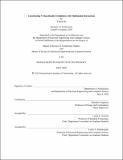Constructing virtual reality exhibitions with multimodal interactions
Author(s)
Jia, Yichen,S. M.Massachusetts Institute of Technology.
Download1193319853-MIT.pdf (22.49Mb)
Other Contributors
Massachusetts Institute of Technology. Department of Architecture.
Massachusetts Institute of Technology. Department of Electrical Engineering and Computer Science.
Advisor
Takehiko Nagakura.
Terms of use
Metadata
Show full item recordAbstract
Even though the concept of virtual museums is still young compared with "brick and mortar" museums, it has received increasing attention in the past decades. With the rapid development of the internet and ubiquitous digital devices, human activities and focuses have shifted dramatically from physical spaces to the virtual realm, and museums must reconsider its paradigm to remain relevant in this new environment. This thesis studies the concept of virtual museums and how it could be constructed with virtual reality (VR) as the medium. It consists of four parts in terms of methodology: a background study on the evolution of museums and the development of virtual museums; a field survey on the status quo of virtual museums and an observation of existing design methodologies; two case studies, in which two virtual exhibitions in VR are developed and evaluated; and a design guideline and three design templates generated from previous studies, to which museums can refer when designing such exhibitions in VR. The thesis reveals that museums, as cultural institutes, have been changing their identity and shifting their focus throughout the past centuries. As the tension between their new goal to serve the general public and their long-term mission of safeguarding its collection increases, VR has proven to be a good medium for museums to extend the experience and service that museums provide. Compared with traditional physical exhibitions, virtual exhibitions in VR have advantages in terms of their capacity, connectivity, and ability to showcase spatial contexts in an immersive manner with time factors and multimodal interactions. Moreover, they could provide customized or user-generated contents in addition to convenient methods for quantitative user evaluations. A modularized design system and an object-oriented approach could help modern museums to construct exhibitions with capacity, connectivity, immersiveness, and flexibility in an efficient manner.
Description
Thesis: S.M., Massachusetts Institute of Technology, Department of Architecture, May, 2020 Thesis: S.M., Massachusetts Institute of Technology, Department of Electrical Engineering and Computer Science, May, 2020 Cataloged from the official PDF of thesis. Includes bibliographical references (pages 80-83).
Date issued
2020Department
Massachusetts Institute of Technology. Department of Architecture; Massachusetts Institute of Technology. Department of Electrical Engineering and Computer SciencePublisher
Massachusetts Institute of Technology
Keywords
Architecture., Electrical Engineering and Computer Science.